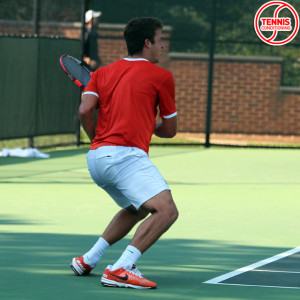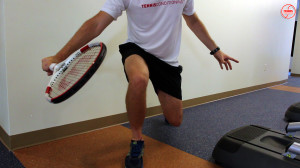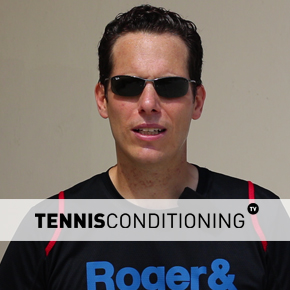Suffering from knee pain can be a nuisance and improving knee strength can be the answer for you to play tennis pain free.
Weather you are Li Na, who just announced her retirement at age 32 due to chronic knee pain, or a college – or junior player, most athletes will experience knee pain sooner or later during their career.
Keep on reading or watch the video and learn about possible knee injuries, reasons for why you experience knee pain and what can cause knee pain, treatment options and workout recommendations.
Possible Injuries Due To Knee Pain
There are numerous possible injuries that can occur – some are less severe, others require surgery and rehabilitation.
In order to come up with the proper diagnosis knowing the location and severity of the pain can help. Possible injuries include:
- Patellar & quadriceps tendinitis (“patellar tendinopathy” or “jumper’s knee”) – inflammation of the tendons; aching/sharp pain often occurs above or below the kneecap (patellar)
- Patellofemoral pain syndrome due to repetitive compressive or shearing forces or muscular imbalances (“lateral tracking”), where the patella is out of alignment, which leads to compensatory muscle action – usually aching pain around and below the kneecap (patellar)
- Ligament sprains & tears – overall joint instability
- Meniscus tears (medial or lateral) – pain is inside (medial) or outside (lateral)
Why Do You Get Knee Pain?
Tennis players can experience knee pain because of various factors, such as:
- Overtraining
- Muscular strength imbalances
Quadriceps/hamstrings (anterior/posterior)
Hip adductors/abductors (medial/lateral)
Calves
- Flexibility issues
Quadriceps/hamstrings
Adductors/abductors
Calves
As a result the musculature surrounding or acting on the knee joint cannot handle the stress placed upon it, which often times happens when the knee protrudes over the toes (see picture below), which can occur during:
- On-court tennis training
- Strength & conditioning

These are factors the tennis and strength & conditioning coaches are responsible for because they are in charge of developing the athlete.
If you have an athlete that is a workaholic or does extra work on his/her own then communicate with the athlete to convince him/her that being healthy is paramount for improving his/her ranking and ultimately a successful career.
Keep in mind that athletes will lie about their pain levels because they want to play tournaments to earn points in order to improve or maintain their ranking.
What they don’t understand is that this kind of behavior will backfire because the body will break down and more severe injuries can occur, which means weeks of no training and loss in confidence and performance and hence a downward spiral with regards to ranking.
The coaches’ job is to make the best decision for their athletes!
Whatever the situation may be the training volume needs to be adjusted accordingly and regular physical therapy needs to be implemented so that injuries can be avoided or minimized even if the athletes are resisting!
What Can Cause Knee Pain?
The aforementioned injuries can occur due to excessive knee flexion and rapid knee extension activities during:
On-court Tennis Training:
- Excessive serving
Knee flexion and rapid extension during service motion (see pictures on the left & center)
Single-leg squat during landing phase (deceleration phase) (see picture on the right)
- Excessive volleying
Forward lunging during low volleys

- Excessive serve & volleying
Transition from single-leg squatting during landing phase and rapid knee extension during the push-off phase with the foot to move the body forward rapidly towards the net

- Excessive ground stroke training
Recovery or pushing off medially towards the center baseline after hitting wide balls
- Intensity is too high (e.g. volume of repetitive shots is too high)
- Insufficient recovery & rest intervals (e.g. 200 serves in a row)
Strength & Conditioning:
- Improper form of execution
Squatting (left)
Forward & lateral lunging (center)
Biking (right)
Downhill running
Uphill running
Stair sprints
- Intensity is too high (e.g. too much weight)
- Insufficient recovery & rest intervals
- Muscular strength imbalances
- Flexibility Issues
In order to avoid or minimize the risk for injury it is desirable to work with a tennis and strength & conditioning coach that have a thorough understanding of the body and it’s functionality to ensure the ongoing health of their athletes!
How can injury be prevented if one doesn’t know how the body is designed and which muscle is responsible for what action?
Treatment Options & Workout Recommendations
- If you experience pain stop playing tennis or physical conditioning immediately, because you don’t know if the injury is serious or not and the risk of causing or aggravating an injury is higher than any possible benefit.
- Get checked out by a sports-related physician, athletic training or physiotherapist who has extensive experience with the knee joint because the knee is a complex joint and the risk for a misdiagnose should be minimized or avoided.
- Once you are pain-free and have clearance to engage again in physical activity you can start with stretching-, strengthening– and balance exercises presented here:









